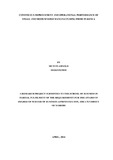| dc.description.abstract | Continuous improvement (CI) as a collection of activities that constitute a process intended to achieve performance improvement. In manufacturing, these activities primarily involve simplification of production processes, chiefly through the elimination of waste. In service industries and the public sector, the focus is on simplification and improved customer service through greater empowerment of individual employees and correspondingly less bureaucracy. Acquisition and use of skills for process analysis and problem solving are seen as fundamental to CI in the private and public sectors. The underpinning principle of KAIZEN (Japanese word for continuous improvement) is the use of various problem-solving tools for the identification and solution of work-based problems. The aim is for improvement to reach new ‘benchmarks’ with every problem that is solved. To consolidate the new benchmark, the improvement must be standardized. In a competitive environment, the challenge for all businesses is not only to innovate in existing markets to survive and remain profitable, but also to innovate in new markets in order to stay in front of competitors. The purpose of the study was to determine the various continuous improvement approaches adopted by small and medium sized manufacturing firms in Kenya and to determine the relationship between the extent of adoption of continuous improvement approaches and operational performance of small and medium sized manufacturing firms in Kenya. This study adopted exploratory research design. The study focused on 2000 manufacturing SMEs in Nairobi and its environs namely Thika, Athi River and Limuru. Using proportional allocation, 70 agro-based, 60 chemical and mining and 70 engineering and construction enterprises were visited by taking 10% from each stratum. A self-administered questionnaire and observation were the two principal research instruments of data collection. The data collected was analyzed by descriptive statistics and inferential statistics. The study established that there is control over processing of products and the firms encourage new products/services development although they do not have a budget for research & development. The study further deduced that the SMEs always anticipate and manage uncertainty and risk. The study concludes that benchmarking had the highest influence on operational performance, followed by best industry practices, then lean supply chain management while innovative and creativity had the least effect on operational performance. The study recommends that the manufacturing SMEs should practice green procurement practices/green purchasing so as to reduced waste in production and enhance their production efficiency. The firms should also engage in cross functional training of their staff on the best practices in a bid to streamline their operations. There is also need for government intervention strategies to support SMEs in Kenya like establishment of policies that favour SMEs in the manufacturing sector to enhance continuous improvement practices. Further, managers need to evaluate the product design, process choice, and the degree of standardization involved in the organization, and can then decide upon the appropriate methods to use to best implement improvement practices. | en_US |

